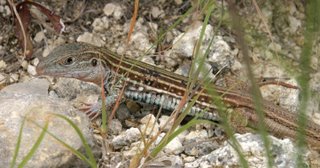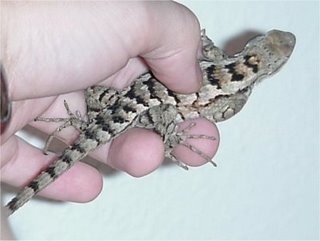Not herpes, herpING!
The hubby and I went on a "herping*" trip down in Sanderson TX this weekend. This was my first-ever herping trip and it was awesome! The reptiles, the scenery, the friends... all made the long drive worth-while.
Just a crip-note about this trip: because of how my body reacts to physical stresses, we had to leave a day early to drive down for this trip. The drive totaled 7 hours for us and we were towing a trailer with my scooter in it.
This extra day allowed me to "rest up" for the weekend's activities. I was able to sleep an extra 6 hours on Friday, giving me more of a fighting chance to be up for our herping activities in the desert on Saturday.
* First off, what is Field Herping?
Field herping is the act of finding Reptiles and Amphibians (herps) in their natural habitat. It is a hobby shared by quite few people compared to things like fishing and hunting. Many people enjoy keeping herps in cages and breeding them and such, but others would rather see and enjoy Reptiles and Amphibians in the wild. Some field herper's like to catch and keep herps, some like to photograph them, and some just like to see them.
You can find Reptiles and Amphibians in the wild by driving along seldom-traveled roads at night or in the day, or by flipping logs and rocks, or by simply walking through suitable habitat.
Before you start field herping, buy field guide and get to know the herps in your area. There could be venomous snakes where you live, so you must know how to properly identify them. When you are turning over objects to find herps, always return them to their original position. Boards, rocks, tin, etc. are all vital parts of the ecosystem where the herps live. Also remember to never litter or leave things behind that may have negative effect on the environment or other herpers.
----------------------Just a crip-note about this trip: because of how my body reacts to physical stresses, we had to leave a day early to drive down for this trip. The drive totaled 7 hours for us and we were towing a trailer with my scooter in it.
This extra day allowed me to "rest up" for the weekend's activities. I was able to sleep an extra 6 hours on Friday, giving me more of a fighting chance to be up for our herping activities in the desert on Saturday.
* First off, what is Field Herping?
Field herping is the act of finding Reptiles and Amphibians (herps) in their natural habitat. It is a hobby shared by quite few people compared to things like fishing and hunting. Many people enjoy keeping herps in cages and breeding them and such, but others would rather see and enjoy Reptiles and Amphibians in the wild. Some field herper's like to catch and keep herps, some like to photograph them, and some just like to see them.
You can find Reptiles and Amphibians in the wild by driving along seldom-traveled roads at night or in the day, or by flipping logs and rocks, or by simply walking through suitable habitat.
Before you start field herping, buy field guide and get to know the herps in your area. There could be venomous snakes where you live, so you must know how to properly identify them. When you are turning over objects to find herps, always return them to their original position. Boards, rocks, tin, etc. are all vital parts of the ecosystem where the herps live. Also remember to never litter or leave things behind that may have negative effect on the environment or other herpers.
Below are some pix (not mine, I'll post those later) of what I saw. The text and pictures are courtesy of this page.
TEXAS HORNED LIZARD (Phrynosoma cornutum)

Sometimes called a Horny Toad, or Horned Toad.
The Texas Horned Lizard is a protected species in the state of Texas, and may not be harassed in any way, or kept in captivity without proper permits.
They are a small lizard that grows from 4 to 6 inches. They feed almost exclusively on harvester ants, so do not make good pets at all.
They are one of the largest species of horned lizard in the United States.
The Texas Horned Lizard is a protected species in the state of Texas, and may not be harassed in any way, or kept in captivity without proper permits.
They are a small lizard that grows from 4 to 6 inches. They feed almost exclusively on harvester ants, so do not make good pets at all.
They are one of the largest species of horned lizard in the United States.
SIX LINED RACERUNNER (Cnemidophorus sexlineatus sexlineatus)

The Six-lined Racerunner is closely related to the Spotted Whiptail.
As their name implies, they are quite fast moving, and generally like areas of open grassland, or rocky areas where it can sun itself. They eat insects, and are quite wary, fleeing at the first sign of a person approaching.
As their name implies, they are quite fast moving, and generally like areas of open grassland, or rocky areas where it can sun itself. They eat insects, and are quite wary, fleeing at the first sign of a person approaching.
TEXAS SPINY LIZARD (Sceloporus olivaceus)

The Texas Spiny Lizard is one of the most common lizards in the Austin area. It is frequently found just about anywhere there are a few naturally growing trees. They are often mistaken for a horned lizard because of their spiny appearance, but unlike horned lizards, the Texas Spiny Lizard climbs trees exceptionally well. Like most lizards, they eat insects which makes them quite beneficial.
Sometimes when a Texas Spiny Lizard is startled, it will leap from a tree and go running noisily through the leaf litter, but because of their camouflage coloring, they can still be difficult to spot.
Sometimes when a Texas Spiny Lizard is startled, it will leap from a tree and go running noisily through the leaf litter, but because of their camouflage coloring, they can still be difficult to spot.
------------------
Click here for more info on Horned Lizards.

Comments